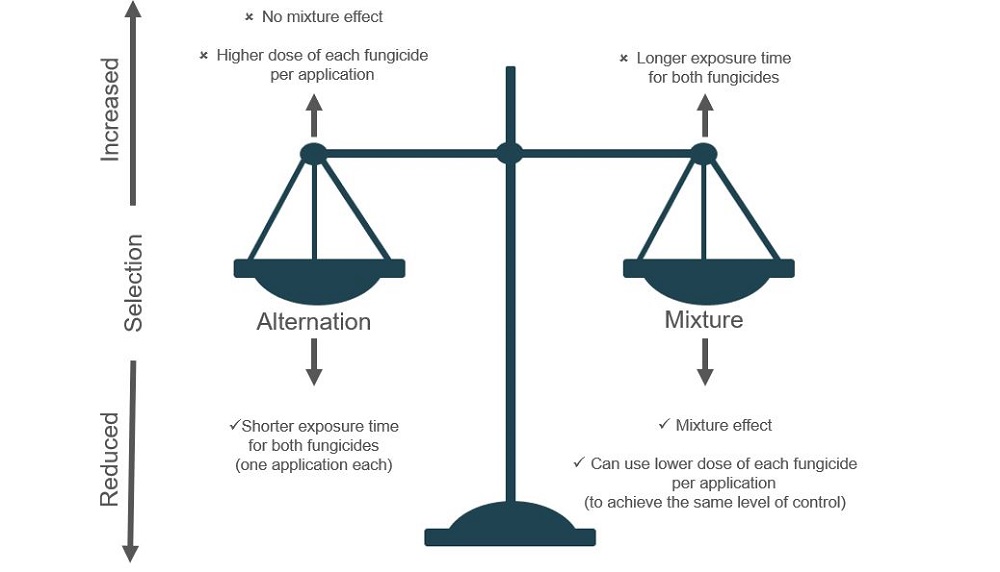The computer model that predicts fungicide resistance
Thursday, 7 September 2023
As the major foliar wheat disease, it is important to understand what makes septoria tritici tick. Jason Pole provides an update on research into fungicide resistance threats.
When septoria tritici (Zymoseptoria tritici) pathogens with reduced sensitivity to strobilurins were first detected in the UK (in 2002), it was a major blow to fungicidal control.
Today, the genetic mutation behind it (G143A) is widespread and fungicides associated with this mode of action (QoI) can no longer be relied upon to control this disease.
Resistance will always evolve and be a threat; the important thing is to learn from it. As such, fungicide resistance management guidance is built upon real-world experience.
However, learning from in-field observations, whether in commercial or trial crops, means the pathogen is winning the race.
The ability to predict resistance, so practice can be altered to reduce resistance risks, is a major research goal.
Resistance guidance
Fungicide Resistance Action Group (FRAG) guidance encourages the use of multiple mode of action groups across fungicide programmes, to reduce the chance of selecting pathogens with reduced sensitivity.
For example, the cereal guidance states:
"Make full use of effective fungicides with different modes of action in mixtures or as alternate sprays."
It is a clear statement. However, there is still uncertainty.
For instance, it is not clear which tactics to use when resistance is developing to multiple mode of action groups at the same time (concurrent evolution).
In this case, it is not known whether mixing or alternating is best.
Considering two or more groups are often used in crop-treatment programmes, it is a big knowledge gap.
Field experiments
To examine this phenomenon, AHDB funded field experiments (led by ADAS) to examine septoria control with two major mode of action groups associated with a shift towards reduced fungicide sensitivity – SDHI and DMI (azole) fungicides.
It highlighted potential trade-offs associated with the current approach.
For example, the statutory requirement to limit the number of applications to two SDHI fungicide-containing sprays per season can limit potentially effective mixture options at other spray timings and result in more alternation.
The work also examined whether selection for resistance was affected by splitting doses. This investigated the same total fungicide dose applied in a single or across multiple applications.
The results were variable: in some trials, splitting the dose increased selection, but in others it did not.
Unfortunately, due to this variability, large numbers of field trials (over several years) would be needed to draw firm conclusions about how to balance trade-offs for resistance management.
Thankfully, there is another way build understanding.
Computer models
As part of an AHDB-funded PhD study at Rothamsted Research, Isabel Corkley uses a model that considers many parameters, including how pathogen development is affected by fungicides.
The approach allows numerous ‘what-if’ scenarios to be run to examine the trade-offs associated with resistance management tactics.
It can be done relatively quickly without the need for a large budget to cover the costs of field trials.
Set to conclude later this year, the interim results (for fungicides at risk of resistance) suggest:
- Overall, fungicide efficacy has the greatest effect on the selection pressure for resistant strains (when initially present at low frequencies)
- The more effective the fungicide, the faster the selection for resistance (whether the total dose is applied in a single application or split across two)
- Using a lower total dose reduces resistance selection (if sufficient disease control can be maintained)
- On average, splitting doses increases resistance selection (with a range of about 0–40%)
- The dose-splitting effect is greatest for fungicides with a medium duration of fungicidal activity (applies to most commercially available fungicides)
- Environmental factors affect the duration of fungicidal activity (likely to contribute to the variability in the dose-splitting effect observed in the field trials)
Interim conclusions
The modelling work and the field experiments show dose-splitting effects are highly variable.
This variability means that it could take many years to generate the robust data required to change resistance management guidance.
FRAG guidance is based upon best-available knowledge and should be followed when designing fungicide programmes.
Always aim to minimise the number of applications, but follow a programme that minimises the total dose of at-risk fungicides and maintains an acceptable level of disease control.
Integrated pest management (IPM) measures that delay and limit disease progression are important.
For septoria tritici, this includes selecting varieties with a high Recommended Lists (RL) disease resistance rating and sowing later (to reduce exposure to spores).
Further information
Resistance ‘trade-offs’ associated with fungicide strategies
 Rothamsted Research/AHDB
Rothamsted Research/AHDB
 in wheat shown on a laptop.JPG) AHDB
AHDB


